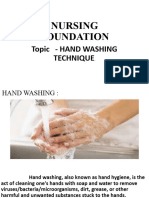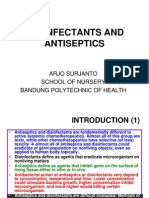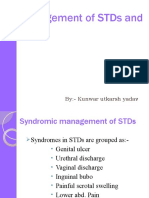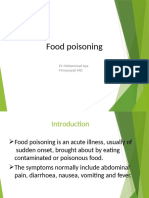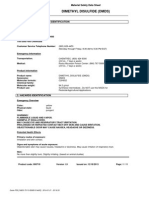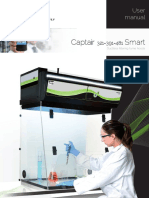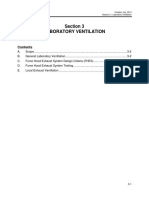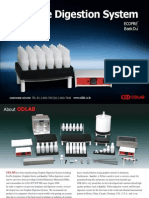SOP Dimethyl Sulfoxide
SOP Dimethyl Sulfoxide
Uploaded by
sliphCopyright:
Available Formats
SOP Dimethyl Sulfoxide
SOP Dimethyl Sulfoxide
Uploaded by
sliphCopyright
Available Formats
Share this document
Did you find this document useful?
Is this content inappropriate?
Copyright:
Available Formats
SOP Dimethyl Sulfoxide
SOP Dimethyl Sulfoxide
Uploaded by
sliphCopyright:
Available Formats
1
Standard Operating
Procedure (SOP)
Template
DIMETHYL SULFOXIDE (DMSO)
Effective Date: 1/18/2012 Revised Date: 1/31/2012
INTRODUCTION
A Standard Operating Procedure (SOP) describes how your lab will handle a hazardous
chemical safely, including the amount and concentration you will use, how you obtain or create
the working solution, and special handling procedures, engineering controls, and personal
protective equipment. Chemical-specific SOPs are found on the EH&S website.
Wake Forest Baptist Medical Center has created Standard Operating Procedures (SOPs) for
several chemical hazard categories and some commonly-used chemicals. The SOP provides
only standard information and requires customization for each lab.
The Occupational Safety and Health Administration (OSHA) requires a written SOP for any work
with hazardous chemicals in laboratories. There are additional requirements for SOPs for
particularly hazardous substances, or PHSs. These SOPs are an important part of the Chemical
Hygiene Plan.
GENERAL LAB RULES
1. No eating, drinking, smoking, handling contact lenses, or applying cosmetics in the
laboratory.
2. Persons shall wear buttoned lab coat, long pants, safety glasses or goggles and
appropriate gloves when working with hazardous chemicals.
3. Mouth pipetting is prohibited; mechanical pipetting devices are to be used at all times.
4. All procedures are performed carefully to minimize the creation of splashes or aerosols.
5. Wash hands
after handling chemicals materials,
after removing gloves, and
before leaving the laboratory.
6. Plastic ware should be substituted for glassware whenever possible
Add Lab Specific Rules Here
2
2 0
2
Standard Operating
Procedure (SOP)
Template
DIMETHYL SULFOXIDE (DMSO)
Effective Date: 1/18/2012 Revised Date: 1/31/2012
PURPOSE
Add Lab Specific Purpose Here
PHYSICAL HAZARDS
Colorless, essentially odorless liquid.
Flash point is 192F.
Incompatibilities and Reactivities: organic and inorganic acid chlorides, strong oxidizing
agents, alkali metals, hydrobromic acid, and acidic solutions of alkali bromides;
prolonged heating above 150C can cause rapid decomposition.
Freezes (solidifies) at 18C (64F).
HEALTH HAZARDS
DIMETHYL SULFOXIDE has shown very few toxic symptoms in humans.
The most common are nausea, skin rashes and an unusual garlic-onion-oyster smell on
body and breath.
High vapor concentrations may cause headache, dizziness, and sedation.
Stinging and burning of the skin as well as rashes and vesicles have been seen. A heat
reaction may occur if applied to wet skin.
Avoid contact with DIMETHYL SULFOXIDE solutions containing toxic material or
materials whose toxicological properties are not known.
DIMETHYL SULFOXIDE easily penetrates the skin, but because of DIMETHYL
SULFOXIDEs low toxicity and the fact that DIMETHYL SULFOXIDE does not carry less-
permeable substances with it through the skin, it can be concluded that DIMETHYL
SULFOXIDE does not pose a significant threat by skin absorption.
2
2 0
3
Standard Operating
Procedure (SOP)
Template
DIMETHYL SULFOXIDE (DMSO)
Effective Date: 1/18/2012 Revised Date: 1/31/2012
PERSONAL PROTECTIVE EQUIPMENT
EYE PROTECTION
Safety glasses, goggles or face shields shall be worn during operations in which
DIMETHYL SULFOXIDE (DMSO) might contact the eyes (e.g., through vapors or
splashes of solution).
Ordinary (street) prescription glasses do not provide adequate protection. Adequate
safety glasses must meet the requirements of the Practice for Occupational Education
Eye and Face Protection (ANSI Z87.1-1989) and must be equipped with side shields.
Wearing contact lenses under some circumstances provides workers with a greater
choice of eye and face protection (such as goggles or full-facepiece respirators without
prescription inserts) as well as better visual acuity. However, the risk is unknown for
contact lens wearers compared with nonwearers working with chemicals listed in the
NIOSH Pocket Guide to Chemical Hazards [NIOSH 2004]. OSHA recommends against
contact lens use when working with acrylonitrile, methylene chloride, 1,2 dibromo-3-
chloropropane, ethylene oxide, and methylene dianiline. NIOSH Publication No. 2005-
139: Current Intelligence Bulletin 59, Contact Lens Use in a Chemical Environment.
HAND PROTECTION
Use disposable nitrile gloves when working with chemicals. Nitrile gloves are
not recommended for use with DMSO if extended contact with the hands is expected.
Some brands of nitrile gloves have degradation times of five minutes when used with
DMSO. DMSO freely penetrates the skin and may carry dissolved chemicals with it into
the body, so hand protection is especially important if you are working with any
hazardous materials dissolved in DMSO. Change gloves regularly if working with DMSO
for an extended period of time.
Laboratory personnel should thoroughly wash hands with soap and water before and
immediately upon removal of gloves.
Nitrile gloves are not recommended for use with DMSO if extended contact with the
hands is expected. Some brands of nitrile gloves have degradation times of five minutes
when used with DMSO. DMSO freely penetrates the skin and may carry dissolved
chemicals with it into the body, so hand protection is especially important if you are
working with any hazardous materials dissolved in DMSO.
LAB COATS, ETC.
Button lab coats, closed toed shoes, long pants and long sleeved clothing shall be worn
when handling DIMETHYL SULFOXIDE (DMSO). Protective clothing shall be worn to
prevent any possibility of skin contact with DIMETHYL SULFOXIDE (DMSO).
2
2 0
4
Standard Operating
Procedure (SOP)
Template
DIMETHYL SULFOXIDE (DMSO)
Effective Date: 1/18/2012 Revised Date: 1/31/2012
SAFETY SHOWER/EYEWASH
Where the eyes or body of any person may be exposed to DIMETHYL SULFOXIDE,
suitable facilities for quick drench or flushing of the eyes and body must be provided
within the work area for immediate emergency use.
Bottle type eyewash stations are not acceptable.
DESIGNATED AREA FOR USE AND CONTAINMENT DEVICES
It is recommended that all DIMETHYL SULFOXIDE (DMSO) work be conducted in the
laboratory fume hood. When working with volatile, toxic chemicals, in limited amounts,
Biological Safety Cabinets (BSC) Class II, Type A2 exhausted or Class II, Types B1and
B2 BSCs exhausted to the outside can be used.
The fume hoods sash must be in the position where a face velocity of 100 feet per
minute is achieved. The BSC must be certified annually by a qualified outside vendor.
Environmental Health and Safety certifies fume hoods annually and places a yellow
sticker to indicate the date of certification and the proper sash height for achieving
proper fume hood face velocity.
Contact Engineering (716-4351) immediately if fume hood is malfunctioning.
SPECIAL HANDLING PROCEDURES AND STORAGE REQUIREMENTS
Store in a cool dry place.
Keep away from heat and open flame.
Keep tightly closed.
Store away from heat and light.
Distill with caution.
Keep container tightly closed, in a well-ventilated place.
Add Lab Specific Special Handling/Storage Procedures
2
2 0
5
Standard Operating
Procedure (SOP)
Template
DIMETHYL SULFOXIDE (DMSO)
Effective Date: 1/18/2012 Revised Date: 1/31/2012
EMPLOYEE EXPOSURE MONITORING
Users of chemical are required to notify EH&S at 716-9375 so air sampling/monitoring
may be performed to determine exposure level.
Individuals planning a family or pregnant can contact EH&S for exposure determination,
consultation, and recommendations.
Exposure monitoring through EH&S is free of charge.
CHEMICAL USE WITH ANIMALS
Click here to enter text. Please consider other routes of exposure when handling animal (e.g.,
cage sign and) and animal bedding.
WASTE DISPOSAL
Chemicals shall not be drain disposed.
Excess DIMETHYL SULFOXIDE (DMSO) and all waste material containing DIMETHYL
SULFOXIDE (DMSO) must be placed in an unbreakable secondary container labeled
with the following HAZARDOUS WASTE DIMETHYL SULFOXIDE (DMSO).
Full containers of DIMETHYL SULFOXIDE (DMSO) waste must be disposed of
according to the EH&S Hazardous Waste Program.
A Waste Ticket must be completed and submitted prior to disposing of chemical through
EH&S.
EMERGENCY PROCEDURES
Emergency Numbers:
Fire and Medical Emergencies 716-9111
(9 + 911 for Friedberg and PTRP
campuses)
Principal Investigators Emergency Number Click here to enter text.
Employee Health 716-4801
Hospital Emergency Room 716-9008
Environmental Health and Safety 716-9375
2
2 0
6
Standard Operating
Procedure (SOP)
Template
DIMETHYL SULFOXIDE (DMSO)
Effective Date: 1/18/2012 Revised Date: 1/31/2012
Laboratory Contact Information:
Click here to enter text. Click here to enter text.
Click here to enter text. Click here to enter text.
Click here to enter text. Click here to enter text.
FIRST AID
The nearest safety shower station is located: Insert text here
The nearest safety eyewash is located: Insert text here
If chemical exposure occurs, flush exposed area for 15 to 20 minutes using emergency
eyewash station and/or safety shower.
Call 716-9111 and describe the extent of injuries, chemical spilled and the amount.
Keep people out of the area.
Report all accidental exposures to Employee Health Services.
Complete an online injury/illness report if there is an over-exposure to the chemical or if
there is an accident involving the chemical.
SPILL AND ACCIDENT PROCEDURES
If the chemical spilled is considered a carcinogen, reproductive toxin or highly toxic chemical,
contact 716-9111 and evacuate area immediately, regardless of spill amount. If you are unsure
of type of chemical, contact 716-9111. For all other spills use the chart below for spill reporting
and response: Chemical Spill Procedures
SPILL QUANTITY PROPER SPILL RESPONSE
Spill less than 300 mL Contact Environmental Health and Safety (716-
9375) and clean up spill using spill kit.
Spill greater than 300 mL Do not attempt to clean up spill. Leave the
Area and immediately report to WFBMC
Security (716-9111).
2
2 0
7
CERTIFICATION OF APPLICATION
PLEASE READ
THESE ITEMS AUTOMATICALLY BECOME A PART OF YOUR SOP
1. I understand that it is my responsibility to assure that all personnel working in my
laboratory with any of these hazards are fully informed about their specific dangers,
proper actions for safe use, steps to take in case of accidents, and are provided with all
necessary safety equipment and instructions in its use.
2. I agree to follow the provisions of the Chemical Hygiene Plan.
3. I will ensure that all of my personnel attend Basic Lab Safety Training by EH&S prior to
using chemical materials.
4. I agree to permit Representatives of WFSM Environmental Health and Safety to inspect
the facilities where this work is being conducted.
5. All chemical waste will be disposed of through EH&S Chemical Waste Program. I
understand that drain disposal is NOT allowed.
6. Chemical materials will be transported in closed containers.
7. Sharps and/or breakable plastic solid waste items will be placed in approved puncture-
resistant container, i.e., a sharps container.
8. As soon as possible, the Chemical Occupational Hygiene Officer will be notified in
writing of any proposed changes in locations where chemical materials are stored or
used.
9. Additional chemicals or changes in possession limits will be requested in writing from the
Chemical Occupational Hygiene Officer.
10. Chemical materials will not be transferred to other Authorized Users without prior
approval of the Chemical Occupational Hygiene Officer.
11. Chemical materials will not be shipped anywhere off campus without prior approval of
the Chemical Occupational Hygiene Officer.
12. Secure chemicals (including waste) to prevent unauthorized access or removal. In
addition, you must control and maintain constant surveillance of chemicals that are not in
storage or are in use. This can be achieved by: 1) Locking refrigerators and/or storage
cabinets, 2) Locking the laboratory when no one is present, and 3) Challenging unknown
persons entering the laboratory.
13. I will notify the Chemical Occupational Hygiene Officer of my intent to leave WFUHS at
least 60 days in advance. I will be responsible for disposing of my chemical materials
inventory through EH&S Chemical Waste Program.
First Last Signature
Click here to enter text. Click here to enter text.
Click here to enter text. Click here to enter text.
Click here to enter text. Click here to enter text.
Click here to enter text. Click here to enter text.
Click here to enter text. Click here to enter text.
Click here to enter text. Click here to enter text.
Click here to enter text. Click here to enter text.
You might also like
- Lab Lec 1a - Laboratory Rules and Safety PrecautionsDocument52 pagesLab Lec 1a - Laboratory Rules and Safety Precautionsrosecel jayson ricoNo ratings yet
- AFA1000/E MK2 VAV Airflow Controller: Installation & Operating ManualDocument78 pagesAFA1000/E MK2 VAV Airflow Controller: Installation & Operating ManualLucas fortunatoNo ratings yet
- A Novel and Efficient Synthesis of CadaverineDocument412 pagesA Novel and Efficient Synthesis of CadaverineS. A. ScogginNo ratings yet
- Handbook - Fume HoodsDocument137 pagesHandbook - Fume Hoodsmnt6176100% (5)
- Hand Washing TechniqueDocument17 pagesHand Washing Techniquesaranya amuNo ratings yet
- Blood ProductsDocument41 pagesBlood ProductsrijjorajooNo ratings yet
- Cold SterilizationDocument28 pagesCold SterilizationInsha100% (1)
- Pharmacology Volume 1 Unit 2 AntisepticsDocument59 pagesPharmacology Volume 1 Unit 2 AntisepticsAkhilesh TiwariNo ratings yet
- (Blood Glucose) Department of Public Health Spring 2020, Lab Manual (PBH101L)Document2 pages(Blood Glucose) Department of Public Health Spring 2020, Lab Manual (PBH101L)Afia Nazmul 1813081630No ratings yet
- Venturi Masks Air Entrainment MaskDocument2 pagesVenturi Masks Air Entrainment MaskReema KhalafNo ratings yet
- Universal Safety (Health) PrecautionsDocument37 pagesUniversal Safety (Health) PrecautionsElizabeth Catharine Sianipar100% (1)
- India - Guidelines - WIFSDocument42 pagesIndia - Guidelines - WIFSdiana.alyNo ratings yet
- Oral Rehydration TherapyDocument12 pagesOral Rehydration TherapypasambalyrradjohndarNo ratings yet
- Sterilisation and DisinfectionDocument121 pagesSterilisation and DisinfectionSreelekshmi JNo ratings yet
- N7 by Novo - Methods of ContraceptionDocument34 pagesN7 by Novo - Methods of ContraceptionEllen Rose NovoNo ratings yet
- Desinfectants and AntisepticsDocument14 pagesDesinfectants and AntisepticsAri Sri WulandariNo ratings yet
- Dispensing PracticeDocument86 pagesDispensing PracticeVon Valentine MhuteNo ratings yet
- Fluids and Electrolyte DisturbancesDocument103 pagesFluids and Electrolyte Disturbancesanreilegarde100% (1)
- 7 Sterilization Disinfection MedicalDocument28 pages7 Sterilization Disinfection MedicalNurhidayah NoordinNo ratings yet
- What Dressing For What Wound: Prudence Lennox National Clinical Leader Healthcare Rehabilitation LTDDocument37 pagesWhat Dressing For What Wound: Prudence Lennox National Clinical Leader Healthcare Rehabilitation LTDImafighter4HimNo ratings yet
- Presentation 6 Isolation Precaution FinalDocument33 pagesPresentation 6 Isolation Precaution FinalAfeefa Amin AliNo ratings yet
- Common ColdDocument3 pagesCommon Coldanisa rimadhaniNo ratings yet
- Carbohydrate DigestionDocument12 pagesCarbohydrate DigestionayeshaNo ratings yet
- Management of Sexually Transmitted Diseases and Hiv AidsDocument28 pagesManagement of Sexually Transmitted Diseases and Hiv AidsUtkarsh YadavNo ratings yet
- AmmoniumChloride PDFDocument3 pagesAmmoniumChloride PDFAP TOROBXNo ratings yet
- Hospital Pharmacy: Distribution of Surgical SuppliesDocument7 pagesHospital Pharmacy: Distribution of Surgical SuppliesAsjadNo ratings yet
- Antigen and Antibody ReactionDocument35 pagesAntigen and Antibody ReactionDinda ArmeliaNo ratings yet
- Stomatitis - AHNDocument22 pagesStomatitis - AHNZimran SalimNo ratings yet
- Dermatologic PharmacologyDocument31 pagesDermatologic PharmacologyFor ChristNo ratings yet
- Hookworm Disease: Ancylostoma Duodenale-Are Anthropophilic Human Hookworms Transmitted From Infected SoilDocument5 pagesHookworm Disease: Ancylostoma Duodenale-Are Anthropophilic Human Hookworms Transmitted From Infected SoilBrix Valdriz100% (1)
- Diarrhea: ChildrenDocument16 pagesDiarrhea: ChildrenEmmi Valentina PardedeNo ratings yet
- FormaldehydeDocument17 pagesFormaldehydeAe Silvestre100% (1)
- Food Poisoning: DR Muhammad Isya Firmansyah MDDocument26 pagesFood Poisoning: DR Muhammad Isya Firmansyah MDilo nurseNo ratings yet
- Oxytocic & TocolyticDocument12 pagesOxytocic & TocolyticFahmi Dwika Hafiz TrionoNo ratings yet
- Acute Diarrheal Disease Profound Secretory Diarrhoea Dehydration Hypovolemic Shock Native To The Ganges DeltaDocument24 pagesAcute Diarrheal Disease Profound Secretory Diarrhoea Dehydration Hypovolemic Shock Native To The Ganges DeltacipacipaaNo ratings yet
- Infection ControlDocument52 pagesInfection ControlNor Nadia ZakariaNo ratings yet
- Good Clinical Practice in Pharmacovigilance StudiesDocument11 pagesGood Clinical Practice in Pharmacovigilance Studiesaadrika negiNo ratings yet
- WdiDocument11 pagesWdiAnonymous WKtBPlKNo ratings yet
- Microsoft PowerPoint - Funda 1stDocument59 pagesMicrosoft PowerPoint - Funda 1stCHALIE MEQUNo ratings yet
- Esophageal VaricesDocument4 pagesEsophageal VaricesSnapeSnapeNo ratings yet
- Obstetrics & Gynecology: Course ObjectivesDocument3 pagesObstetrics & Gynecology: Course Objectivespavi7muruganathan100% (1)
- Infectious Diseases: Robin Cochran-Dirksen (Many Slides From Bioedonline Baylor Christine Herrmann PHD)Document21 pagesInfectious Diseases: Robin Cochran-Dirksen (Many Slides From Bioedonline Baylor Christine Herrmann PHD)Aalia Azraei100% (1)
- Introduction To Critical Care NursingDocument33 pagesIntroduction To Critical Care NursingIbrahim RegachoNo ratings yet
- Medicinal Chemistry Iii Lab ManualDocument35 pagesMedicinal Chemistry Iii Lab ManualChetan KhicharNo ratings yet
- Sterilization and DisinfectionDocument41 pagesSterilization and DisinfectionqiotenseiNo ratings yet
- Synthetic Antibacterial AgentsDocument58 pagesSynthetic Antibacterial AgentsApurba Sarker Apu100% (3)
- Prevention of CovidDocument3 pagesPrevention of CovidRodmar EscolanoNo ratings yet
- Widal TestDocument8 pagesWidal TestSanam BangashNo ratings yet
- AnaemiaDocument15 pagesAnaemiaAnik SinghNo ratings yet
- AMOEBIASISDocument8 pagesAMOEBIASISCheska ت HortelanoNo ratings yet
- Complete Stool ExaminationDocument4 pagesComplete Stool Examinationnaxo128No ratings yet
- Differential Diagnosis of Diabetes MellitusDocument8 pagesDifferential Diagnosis of Diabetes MellitusKevin LuwisNo ratings yet
- Glucose EstimationDocument10 pagesGlucose EstimationZahidKhanNo ratings yet
- Dracunculus Medinensis: SynonymsDocument24 pagesDracunculus Medinensis: SynonymsFatemaNo ratings yet
- Drug Nomenclature: MR - Manikanta TMCDocument5 pagesDrug Nomenclature: MR - Manikanta TMCManikanta GupthaNo ratings yet
- Body TemperatureDocument26 pagesBody TemperatureChinniah RamkumarNo ratings yet
- Pharmacotherapy of Peptic Ulcer: DR ZareenDocument50 pagesPharmacotherapy of Peptic Ulcer: DR ZareenGareth BaleNo ratings yet
- Disease Condition... Diabetes MellitusDocument6 pagesDisease Condition... Diabetes MellitusSimran JosanNo ratings yet
- Plasma ExpandersDocument21 pagesPlasma ExpandersvimalaNo ratings yet
- Chemical BurnDocument14 pagesChemical BurnSyidah RoslanNo ratings yet
- Factors Affecting SterilizationDocument25 pagesFactors Affecting SterilizationJoeann WilsonNo ratings yet
- Widal Test: Dr. Neelu Jain Department of Microbiology B.M.CDocument25 pagesWidal Test: Dr. Neelu Jain Department of Microbiology B.M.Cnafiul islamNo ratings yet
- The politics of hunger: Protest, poverty and policy in England, <i>c.</i> 1750–<i>c.</i> 1840From EverandThe politics of hunger: Protest, poverty and policy in England, <i>c.</i> 1750–<i>c.</i> 1840No ratings yet
- DMDS MSDSDocument11 pagesDMDS MSDSamirhosseine00No ratings yet
- SECTION 23 05 93 Testing, Adjusting, and Balancing For Hvac: Based On DFD Master Specification Dated 03/03/2020Document7 pagesSECTION 23 05 93 Testing, Adjusting, and Balancing For Hvac: Based On DFD Master Specification Dated 03/03/2020Jidu M DivakaranNo ratings yet
- A6V10307387 enDocument7 pagesA6V10307387 enESNo ratings yet
- Unc Laboratory Design GuidelinesDocument38 pagesUnc Laboratory Design GuidelinesTanveer AzizNo ratings yet
- Statement of ComplianceDocument82 pagesStatement of Complianceفاطمة قمرالدينNo ratings yet
- Isn Check List: Student) Belong Cover Erudites, Amity, Candor, Abnegation)Document6 pagesIsn Check List: Student) Belong Cover Erudites, Amity, Candor, Abnegation)joyNo ratings yet
- Catálogo Mepamsa 2018Document43 pagesCatálogo Mepamsa 2018Luis FloresNo ratings yet
- Thermo Hamilton Safeaire Fume Hood ManualDocument32 pagesThermo Hamilton Safeaire Fume Hood ManualAditya PrajasNo ratings yet
- SQG Labs 2Document8 pagesSQG Labs 2Pedro SilvaNo ratings yet
- TROX Air Flow Control Design ManualDocument36 pagesTROX Air Flow Control Design Manualiask5275No ratings yet
- Radiation Laboratory Design Guidance Note Draft 2.1Document18 pagesRadiation Laboratory Design Guidance Note Draft 2.1Radiation Safety Unit - University of ManchesterNo ratings yet
- Ashrae Etf Lab GuidanceDocument32 pagesAshrae Etf Lab Guidance_srobert_No ratings yet
- Manual Campana Extracción - Captair - Smart - 321 - 391 - 481 - User - Manual - ENDocument23 pagesManual Campana Extracción - Captair - Smart - 321 - 391 - 481 - User - Manual - ENTincho ValleverdeNo ratings yet
- 929 R1-AnnexureDocument1 page929 R1-AnnexureDharmendra SNo ratings yet
- HSE-LS-05 Fume Hood Training Handout PDFDocument15 pagesHSE-LS-05 Fume Hood Training Handout PDFAkhil AbrahamNo ratings yet
- Utilities QualificationDocument162 pagesUtilities QualificationDoan Chi ThienNo ratings yet
- COMPANY Catalogue - PROEDocument18 pagesCOMPANY Catalogue - PROEkhai ruleNo ratings yet
- Customs Laboratory GuideDocument175 pagesCustoms Laboratory GuideMuhamad MakmuriNo ratings yet
- S 3 Lab VentilationDocument5 pagesS 3 Lab VentilationElena JavierNo ratings yet
- (ODLAB) Catalogue (Eng)Document20 pages(ODLAB) Catalogue (Eng)vateloki7No ratings yet
- Standard Fume Hood Catalog Labstac LLCDocument8 pagesStandard Fume Hood Catalog Labstac LLCSophia HillNo ratings yet
- En-Ico Ncat 4740Document166 pagesEn-Ico Ncat 4740สํานักวิเคราะห์และตรวจสอบ ส่วนสํารวจและประเมินสภาพทางNo ratings yet
- Fume Hood - CatalogDocument6 pagesFume Hood - Catalogdéborah_rosalesNo ratings yet
- Fume Hoods ManualDocument9 pagesFume Hoods ManualkmthongNo ratings yet
- Brosur - Fume Hood DuoDocument4 pagesBrosur - Fume Hood DuoNiezhaNo ratings yet
- 01 Chemical Handling Procedure PDFDocument6 pages01 Chemical Handling Procedure PDFAmol Kashid100% (1)
- 05 X30 User's Manual (MKT-0012)Document44 pages05 X30 User's Manual (MKT-0012)VICTOR MANUEL SALAZAR GARCIANo ratings yet




